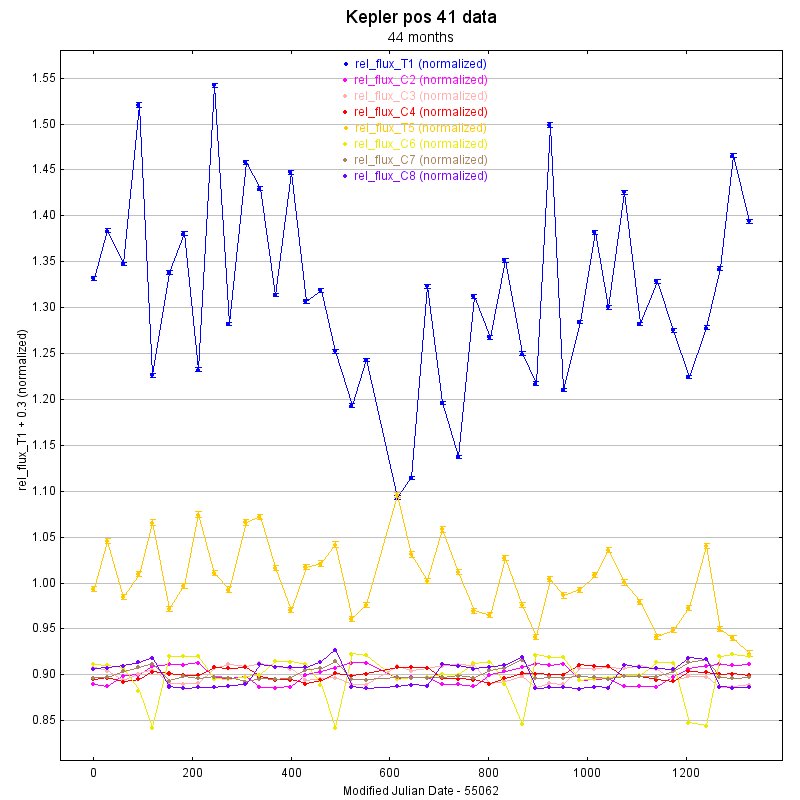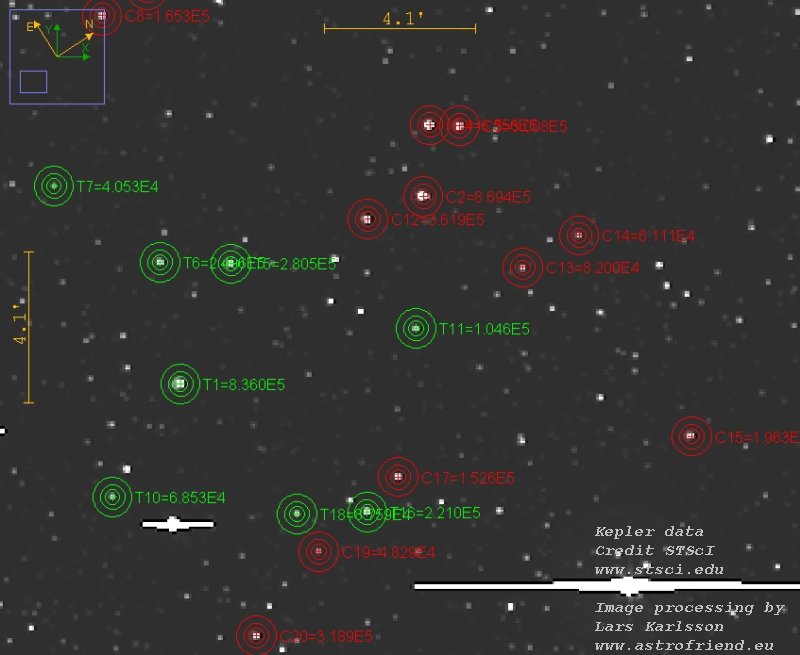|
Advertisement / Annons: |
Astronomy Science Data
|

|
| Coordinates/Direction : | RA: 290.427033o, DEC: +43.624771o. Angle calculator |
| Object size : | sensor about 1 x 1 degrees |
| Object magnitude : | - |
| Object : | Area of Cygnus, Lyra and Draco |
| Date : | 2009-08-19 to 2013-04-08 |
| Lens/telescope : | Kepler Space observatory |
| Film/CCD : | Sensor position 41 (from sensor 41, 42, 43, 44), Kepler data, credits: STScI |
| Filter/Wavelength : | 420 to 900 nm |
| Exp. time : | 27 minutes x 44 frames |
| Image process tool : | AstroImageJ, Fitswork, Irfanview |
| Processing : | Multi aperture analyze |
| Site : | Space |
| Comment : |
Here I with differential photometry looking for stars that just have small amounts of variation relative there neighbor stars.
Just by random pick up sets of 8 stars and compare them against each other.
After a while I found these two stars that have a different pattern compare to the other 6 stars that I use as reference stars. I have not find out which stars these are yet. Update: With help from Thomas K and Hans Bengtsson I now know that the T1 star is ASAS J192437+4334.4 (KIC 7820467). Hans Bengtsson also found that the star T5 is an earlier not known variable KIC 7888888, but needs follow up analyzes. See below. |
| More to know : |
T1 star ASAS J192437+4334.4 (KIC 7820467): https://www.aavso.org/vsx/ index.php ... http://simbad.u-strasbg.fr/ simbad ... T5 star, 2MASS J19241840+4336434 (KIC 7888888): http://vizier.u-strasbg.fr/ ... |
Differential Photometry of variable star with micro variations |

|
| Image process tool : | AstroImageJ, Irfanview |
| Processing : | Multi aperture analyze |
| Site : | Space |
| Comment : |
At bottom the 6 ref stars, they are offset along the Y-axis.
Above, the yellow and blue line are the two stars that have a different pattern compare to the reference stars. Update: With a lot of help from Hans Bengtsson the T5 star (yellow line) is now reported as a new variable: https://www.aavso.org/ vsx/ index.php? view=detail.top &oid=608444 |
| More to know : |
Semi regular variable star, Wikipedia: https://en.wikipedia.org/ wiki/ Semiregular variable star |
One more analyze of T5 data, object 3, Kepler data pos 41 |

|
| Coordinates/Direction : | RA: 290.427033o, DEC: +43.624771o. Angle calculator |
| Object size : | crop area about 0.2 x 0.2 degrees |
| Object magnitude : | - |
| Object : | Area of Cygnus, Lyra and Draco |
| Date : | 2009-08-19 to 2013-04-08 |
| Lens/telescope : | Kepler Space observatory |
| Film/CCD : | Sensor position 41 (from sensor 41, 42, 43, 44), Kepler data, credits: STScI |
| Filter/Wavelength : | 420 to 900 nm |
| Exp. time : | 27 minutes x 44 frames |
| Image process tool : | AstroImageJ, Fitswork, Irfanview |
| Processing : | Multi aperture analyze |
| Site : | Space |
| Comment : | Now when I gained more experience I have done the analyze of target T1 and T5 once again. More carefully selected reference stars and more of them. At the same time I got 6 more interesting stars to analyze. |
| Objects : |
T1, star ASAS J192437+4334.4 (KIC 7820467): http://simbad.u-strasbg.fr/ simbad ... https://www.aavso.org/vsx/ index.php ... Period 82.6 d T5, star, 2MASS J19241840+4336434 (KIC 7888888): http://vizier.u-strasbg.fr/ ... https://www.aavso.org/ ... Period 42.1 d T6, star, unknown by Simbad, 19:24:29.34 +43:37:30.1: http://vizier.u-strasbg.fr ... T7, star, unknown by Simbad, 19:24:36.54 +43:40:47.1: http://vizier.u-strasbg.fr/ ... T10, star, unknown by Simbad, 19:24:54.22 +43:32:52.8: http://vizier.u-strasbg.fr/ ... T11, KIC 7820062 -- Star: http://simbad.u-strasbg.fr/ simbad ... T16, KIC 7751017 -- Rotationally variable Star: http://simbad.u-strasbg.fr/ simbad ... https://www.aavso.org/ ... Period 3.622 d T18, star, unknown by Simbad, 19:24:32.30 +43:29:48.4: http://vizier.u-strasbg.fr/ ... |
Differential Photometry of variable star with micro variations |

|
| Image process tool : | AstroImageJ, Irfanview |
| Processing : | Multi aperture analyze |
| Site : | Space |
| Comment : |
At top the T1 and T5 data, looks almost the same as earlier,
good, because then I know it's not that very critical which reference star I use.
Among the 20 stars I picked up I have 6 new candidates.
I need to know at what brightness I shall limit my objects, they oversaturate at about 200'000 electrons / second.
Too weak stars and it will be noise and also more difficult to get some data to compare with. By looking at the error bars I see that object T7 has big error bars. Then looking at the signal of T7 I see that it has 40'000 electrons integrated in one second (the unit is electrons / second). I shall not use that weak stars as reference or maybe not as interesting object either. At least not now when I'm in the learning process. |
|
| Go Back |